Looking for some shade loving perennials to add to your landscape? Here’s a list of herbaceous perennial plants that not only tolerate but thrive in shaded conditions.
1. Hosta
Hostas are often considered the quintessential shade garden plant, and for good reason. Their broad, textured leaves come in shades of green, blue, and gold, adding depth and interest to dimly lit garden areas. Unlike many plants that require full sun to thrive, hostas prefer the cooler, more stable temperatures that shaded environments provide. Direct sunlight can actually scorch the delicate leaves of all but the most sun-tolerant varieties, leading to a loss of color vibrancy and overall plant health.
When it comes to ideal planting locations for hostas, they are quite versatile but do best in well-drained, fertile soil. They can be planted under the canopy of deciduous trees, along shaded walkways, or even in containers on a covered patio. Some gardeners use them as ground cover to fill in the understory of larger shrubs and trees. They prefer a soil pH that is slightly acidic to neutral but are generally forgiving and can tolerate less-than-ideal soil conditions.
There are hundreds of hosta cultivars, each with its unique leaf color, shape, and size. Some popular choices for low-light areas include ‘White Feather’, which has near-white leaves when isolated from direct light, and ‘Blue Angel’, known for its blue-gray foliage. ‘Halcyon’ offers smaller, blue leaves and is considered one of the best blue-leaved varieties. ‘Patriot’ and ‘Francee’ are both green and white variegated varieties that are also excellent choices for adding contrast and interest to your shade garden.

2. Ferns
Ferns are another staple in the shade garden, offering a completely different texture and form compared to hostas and other shade-loving perennials. These ancient plants are perfectly adapted to life in the understory, where they spread their fronds in intricate patterns to capture the dappled sunlight filtering through the tree canopy. While some varieties can tolerate bursts of sunlight, many ferns are sensitive to direct exposure, which can result in frond scorching or bleaching. Therefore, they are ideal choices for areas that receive minimal direct sun.
The ideal planting location for ferns would be in a moist, well-drained area rich in organic matter. Ferns naturally thrive in woodland settings, making them great additions under the dappled shade of tall trees or even in north-facing garden spots where many plants won’t prosper. Drainage is key because, while they like moisture, they don’t do well in standing water. Adding compost or organic matter to the planting area can help create the loamy soil that most ferns prefer.
There are numerous types of ferns to choose from, each offering unique frond shapes and growth habits. For deep shade, consider the Christmas Fern (Polystichum acrostichoides), which is evergreen and native to many parts of the U.S. The Maidenhair Fern (Adiantum) is delicate and lacy, making it a favorite for more formal or manicured shade gardens. The Ostrich Fern (Matteuccia struthiopteris) is taller and more robust, and it can spread to form a dense colony if given enough space. The Lady Fern (Athyrium filix-femina) is another versatile choice, known for its finely-cut, lance-shaped fronds.

3. Hellebores
Hellebores are among the few plants that not only tolerate shade but also flower profusely in low-light conditions. The unique, cup-shaped flowers bloom in late winter to early spring, providing much-needed color and interest at a time when most gardens are still dormant. Unlike many other flowering plants that require abundant sunlight to bloom, hellebores are quite content in the shade, which protects their delicate flowers from the harshness of direct sunlight and helps the blooms last longer.
When it comes to planting hellebores, these hardy perennials are not overly fussy. They prefer well-drained soil rich in organic matter, but they are adaptable and can tolerate a variety of soil types, including clay, sandy, and loamy soils. Ideal planting spots include shaded woodland gardens, under the canopy of deciduous trees, or even in the shadow of a building or fence. Although they prefer a consistently moist environment, hellebores are relatively drought-tolerant once established, making them a good choice for drier shade areas as well.
There are many species and cultivars of hellebores to suit any shade garden. The Helleborus orientalis, or Lenten Rose, comes in various colors, from white and pink to deep purples and almost black. The Helleborus niger, or Christmas Rose, blooms even earlier and offers pristine white flowers. ‘Ivory Prince’ is another popular cultivar, notable for its upward-facing blooms and dusky rose color.

4. Columbine
Columbine (Aquilegia) is a stunning perennial that is not only shade-tolerant but brings an ethereal, woodland charm to any garden. With its unique, spurred flowers that resemble miniature lanterns or doves in flight, columbine is a must-have for gardeners looking to add interest and depth to shady corners. The plant’s tolerance for lower light conditions allows it to bloom in vibrant colors, including blues, reds, yellows, and purples, even when not placed in full sun.
The ideal spot for planting columbine would be a location with dappled or partial shade. They can tolerate a range of soil types but prefer well-drained soil that is moderately rich in organic matter. This makes them perfect for planting at the edges of woodlands, beneath deciduous trees, or even in mixed beds where they can be provided some relief from the harsh afternoon sun. While they appreciate consistent moisture, especially when getting established, columbine is also somewhat drought-tolerant, making it a flexible choice for various garden situations.
Several species and hybrids offer the gardener a broad choice of flower shapes and colors. Aquilegia canadensis, the Eastern red columbine, is native to North America and offers red and yellow flowers. The Aquilegia vulgaris group has a variety of garden hybrids that include the stunning ‘Nora Barlow,’ with its rose-like, multi-petaled flowers, and ‘Winky,’ a series of cultivars with upward-facing blooms in a range of two-tone colors. The McKana Group hybrids offer long-spurred flowers in a broad color palette, ideal for attracting hummingbirds. With so many options, it’s easy to find a columbine that fits the aesthetic and conditions of your shade garden.

5. Lily of the valley
Lily of the valley (Convallaria majalis) is a herald of spring in shady gardens, known for its sweetly scented, tiny white bell-shaped flowers. This low-growing perennial spreads through underground rhizomes to form a lush carpet of glossy green leaves, providing both texture and fragrance to areas that don’t receive a lot of sunlight. While many plants struggle to perform in shady conditions, Lily of the Valley actually prefers it, as the shade helps retain soil moisture and keeps the plant’s foliage vibrant.
For best results, Lily of the Valley should be planted in locations with dappled to full shade and in well-drained, humus-rich soil. These plants are perfect for naturalizing under trees, filling in the spaces between larger shrubs, or even covering difficult areas with slopes where other plants struggle to take root. Once established, Lily of the Valley is relatively low-maintenance and can even tolerate poor soil and drought conditions, though it prefers consistently moist soil.
Several cultivars of Lily of the Valley offer variations in flower color and form, although these tend to be less common than the traditional white-flowering type. The ‘Rosea’ cultivar produces delicate pink flowers, while ‘Flore Pleno’ offers double, white blooms. ‘Variegata’ stands out for its green leaves with white edges, adding extra interest even when the plant is not in bloom. Regardless of the specific variety, Lily of the Valley makes for an enchanting, fragrant addition to any shade garden, signaling the arrival of spring with its iconic blossoms.

6. Japanese anemone
Japanese anemone is a perennial plant that thrives in the dappled sunlight of wooded areas, making it a natural choice for shady to partially shady gardens. With its tall, slender stems and simple yet striking saucer-shaped blooms, Japanese Anemones bring a graceful elegance to areas that might otherwise remain bare due to lower light conditions. The flowers, which appear in late summer and last into the fall, come in shades of pink or white and offer a valuable source of late-season color for the garden.
The ideal location for planting Japanese Anemones would be an area with partial to full shade, although they can tolerate some morning sun. These plants prefer rich, well-drained soil that retains moisture but doesn’t become waterlogged. They are well-suited for planting at the back of perennial borders, as they can grow up to 4 feet tall, or in woodland gardens where their delicate blooms can rise above lower-growing foliage. Once established, Japanese Anemones require minimal care and are relatively resistant to pests and diseases, although they may take a couple of seasons to get fully established.
Several cultivars are available that offer a range of forms and flower colors. ‘Honorine Jobert’ is a popular white-flowered cultivar with striking yellow centers. ‘September Charm’ offers single, silvery-pink blooms, and ‘Prinz Heinrich’ features semi-double, deep pink flowers. Because of their late bloom time and preference for shady conditions, Japanese Anemones are an excellent choice for adding interest and color to parts of the garden that might otherwise be overlooked during the autumn months.

7. Coral bells
Coral bells (Heuchera) are a versatile perennial, highly valued for their ability to flourish in shady conditions where many other plants might struggle. With their robust, evergreen foliage that comes in a myriad of colors—from lime green to deep burgundy—and dainty, bell-shaped flowers that hover above the leaves on slender stems, Coral Bells offer a multi-season display that can brighten even the shadiest corners of a garden. They are excellent plants for adding a splash of color and texture to shadowy areas, and they also thrive in containers, where their vibrant leaves can serve as a year-round focal point.
For best results, plant Coral Bells in well-drained, enriched soil that is slightly acidic to neutral in pH. These plants do well in partial to full shade but can tolerate some morning sun if kept consistently moist. Due to their compact size, generally not exceeding 18 inches in height, Coral Bells are perfect for border edges, woodland gardens, or as understory plants beneath taller perennials or shrubs. While they are relatively low-maintenance, they benefit from occasional deadheading to encourage new growth and better flowering.
Various cultivars offer a stunning array of foliage and flower options for every garden palette. Some popular choices include ‘Palace Purple’ with its rich, deep burgundy leaves, ‘Lime Rickey’ for a splash of vibrant green, and ‘Caramel’ which sports warm, earth-toned leaves. Not only do these different cultivars bring an eclectic mix of color to shady areas, but they also attract pollinators like hummingbirds and butterflies during their blooming season, making Coral Bells a delightful and multifunctional addition to any shade garden.

8. Virginia bluebells
Virginia bluebells (Mertensia virginica) are spring-blooming perennials that are well-suited for shady gardens, particularly woodland settings. With their captivating blue, tubular flowers that are bell-shaped and dangle in clusters, these plants can create an enchanting effect in the early spring when many other plants are just starting to emerge. The soft, gray-green foliage forms a perfect backdrop for the vivid flowers, making Virginia bluebells a visual delight in the otherwise dim corners of the garden. Due to their early bloom time, they can take advantage of the sunlight that reaches the forest floor before the deciduous trees fully leaf out.
These native North American wildflowers thrive in humus-rich, well-drained soil and prefer partial to full shade, especially as the temperatures start to rise. They are perfect for naturalizing under deciduous trees or shrubs, where they will receive some sunlight in the early spring but are shaded during the hot summer months. Virginia Bluebells are excellent choices for a woodland garden or as a part of a native plant garden. Their ability to self-seed and spread makes them useful for covering larger areas, but be mindful that they are ephemeral and will die back by mid-summer.
While there aren’t many cultivars available due to their wild nature, the species itself is quite consistent in delivering its signature cobalt blue flowers. If you’re looking for a plant to attract pollinators, Virginia Bluebells are excellent at drawing in early spring bees and butterflies, providing an essential food source during a season when nectar is scarce. Their ability to thrive in shady conditions and bring early-season color makes them an invaluable addition to any shade or woodland garden.

9. Astilbe
Astilbe is a perennial favorite for shade gardens, bringing both vibrant color and intricate texture to darker corners of the landscape. Known for their feathery, plume-like flowers that rise on tall stems above fern-like foliage, Astilbe is available in various colors, from white and pale pink to deep reds and purples. Depending on the variety, the plant usually reaches a height of 1.5 to 5 feet, making it a flexible choice for foreground planting or as a backdrop in a shade garden. What sets Astilbe apart is its ability to flower profusely even in low light, providing a striking contrast to the more subdued greenery commonly found in shaded areas.
Astilbe thrives in well-drained but moisture-retentive, humus-rich soil and prefers partial to full shade. While it is tolerant of a range of soil types, keeping the soil consistently moist is key to its success. This makes it an excellent candidate for planting alongside streams, in boggy areas, or in any garden spot that tends to be damp. The plants are relatively low-maintenance but do benefit from regular deadheading to encourage additional blooms and a more extended flowering season.
Popular cultivars abound, each offering its unique shade of flower and foliage type. Some standouts include ‘Bridal Veil’ for its pristine white plumes, ‘Fanal’ for its deep red blossoms, and ‘Pumila’ for those seeking a dwarf variety that tops out at about a foot in height. These cultivars not only brighten up shaded areas but also serve as excellent cut flowers, and they are known for attracting a variety of pollinators, adding ecological value to their aesthetic appeal. Overall, Astilbe is an excellent plant for anyone looking to add a splash of color to their shade garden.

10. Bleeding heart
Bleeding heart (Dicentra spectabilis) is an iconic shade-loving perennial that boasts unique, heart-shaped flowers. It is particularly cherished for its decorative and romantic blooms that appear in late spring to early summer. These blossoms are usually pink, red, or white and dangle gracefully in arching racemes, resembling a string of hearts. Their striking appearance can bring a whimsical and poetic quality to a shady garden. Reaching heights of 2 to 3 feet, Bleeding Heart forms a clump of feathery foliage that serves as an excellent background for the delicate flowers. Unlike many other shade plants, Bleeding Heart not only tolerates shade but actually thrives in it, especially appreciating the cooler conditions provided by low-light areas.
This charming plant prefers to be situated in well-drained, moist soil rich in organic matter. While it is most at home in partial to full shade, it can tolerate a bit of morning sunlight. However, too much direct sun can cause the foliage to yellow and the flowers to wilt, so it’s best to keep it sheltered from intense light. Excellent planting partners for Bleeding Heart include other shade-loving perennials like hostas and ferns, and it can be a star attraction in woodland gardens, border fronts, and cottage-style landscapes.
Several cultivars offer a range of options for gardeners. ‘Alba’ features stunning white flowers, while ‘Gold Heart’ adds a twist with golden foliage to contrast its pink blooms. ‘Valentine’ offers dark red flowers and more robust growing conditions. The plant is not only a visual delight but also attracts pollinators like bees and hummingbirds, making it a functional as well as a beautiful addition to any shade garden. With proper care and placement, Bleeding Heart can be a show-stopping element in your shady garden spots for years to come.

11. Cardinal flower
Cardinal flower is a captivating perennial that thrives in partial to full shade, making it a top choice for gardeners looking to inject vibrant color into darker corners of the garden. Known for its striking spikes of tubular red flowers, it is a magnet for hummingbirds and a focal point wherever it is planted. The rich red blooms stand tall on slender stalks that can reach heights of 2 to 4 feet, providing an intense contrast to the darker, shade-loving foliage and neighbors in a shaded garden bed. The plant’s shade-loving nature makes it a valuable asset in gardens that receive limited sunlight, and its showy blooms provide a burst of color when many other shade plants offer only varying shades of green.
Cardinal flower thrives in consistently moist, well-drained soil that is rich in organic matter. The plant is native to wetlands and stream banks, making it an excellent candidate for areas of the garden that are prone to dampness or even brief periods of standing water. While it prefers partial to full shade, it is relatively adaptable and can tolerate some morning sun as long as the soil remains moist. Its love for water and shade makes it ideal for planting near ponds, in rain gardens, or in woodland settings where it can receive the shelter and moisture it desires.
Among the popular cultivars, ‘Queen Victoria’ is notable for its dark bronze foliage, which adds an extra layer of contrast to the brilliant red flowers. Another variety to consider is ‘Alba,’ which offers pure white blooms for a softer look. Beyond its visual appeal, Cardinal Flower is recognized for its ecological value, attracting a range of pollinators including hummingbirds and certain types of bees. With proper care, this perennial can be a striking and beneficial addition to any shade garden, offering both visual drama and ecological benefits.







